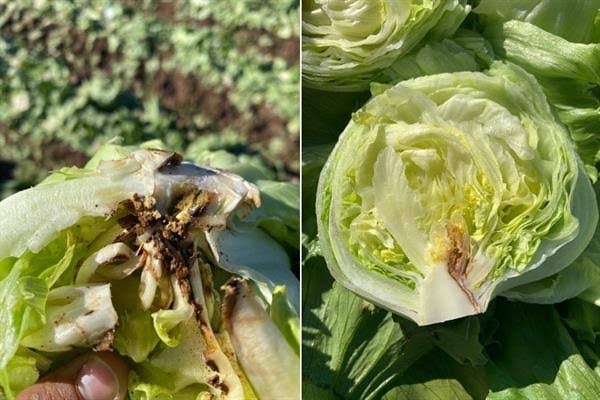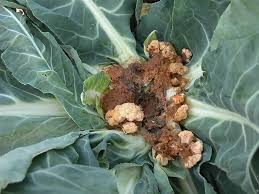Bacterial Soft Rot scientifically known as Erwinia carotovora is a plant disease caused by bacteria that can affect a variety of vegetables and fruits. This condition is characterized by the softening and decay of plant tissues, leading to significant losses in agricultural crops.
The bacteria responsible for Bacterial Soft Rot thrive in warm and humid conditions, making them particularly troublesome for crops in such environments. They enter the plant through wounds or natural openings, initiating the rotting process by breaking down the cell walls and releasing enzymes that contribute to tissue degradation.
Affected plants often exhibit water-soaked lesions, turning them into mushy, slimy masses as the bacteria multiply and spread. This rapid deterioration can lead to the collapse of the affected plant, causing economic setbacks for farmers and impacting food supplies.
Preventing Bacterial Soft Rot involves practicing good agricultural hygiene, which includes minimizing plant wounds during cultivation and harvesting. Proper storage conditions, such as maintaining low humidity levels and adequate ventilation, are essential to curb the growth and spread of the bacteria.
Unfortunately, once Bacterial Soft Rot has taken hold, control measures become challenging. Farmers may resort to removing and destroying infected plants to prevent further contamination. Additionally, the use of antibacterial agents in a preventive manner might offer some protection, but their efficacy can vary.
Research efforts are ongoing to develop resistant plant varieties and explore alternative methods to manage Bacterial Soft Rot effectively. By understanding the biology of the bacteria and their interactions with plants, scientists aim to devise sustainable strategies that minimize the impact of this disease on agriculture.
However, Bacterial Soft Rot poses a significant threat to crops, causing rapid and extensive decay of plant tissues. Addressing this issue requires a multifaceted approach, combining preventative measures, effective agricultural practices, and ongoing research to develop resilient crops and sustainable management strategies.
Read Also: Facts About Honey Bees
Plants Affected by Bacterial Soft Rot (Erwinia carotovora)

Bacterial Soft Rot can affect a wide range of plants, causing substantial damage to various agricultural crops. Among the plants commonly affected are potatoes, carrots, tomatoes, onions, lettuce, and cucumbers. Additionally, cruciferous vegetables such as cabbage and broccoli are susceptible to this bacterial infection.
The bacteria responsible for Bacterial Soft Rot, namely Erwinia carotovora, can exploit wounds or natural openings in these plants to invade and initiate the rotting process. The infection typically leads to the development of water-soaked lesions, followed by the softening and breakdown of plant tissues.
It’s crucial for farmers and growers to be vigilant, as Bacterial Soft Rot can have significant economic implications. Early detection and implementation of preventive measures, such as proper sanitation practices and careful handling during cultivation and harvesting, are essential to minimize the impact of this destructive disease on various crops.
Damages Caused by Bacterial Soft Rot

Bacterial Soft Rot inflicts severe damages on affected plants, resulting in economic losses for farmers and impacting the overall availability of certain crops. The consequences of this bacterial infection include:
1. Decay and Softening of Tissues: The primary damage caused by Bacterial Soft Rot is the rapid decay and softening of plant tissues. This renders the affected fruits and vegetables unmarketable and unsuitable for consumption, leading to financial setbacks for farmers.
2. Crop Losses: Infected plants often experience a significant reduction in yield or total crop loss. This can be particularly devastating for farmers who rely on these crops for their livelihoods and as a food source for local communities.
3. Reduced Shelf Life: Bacterial Soft Rot can dramatically decrease the shelf life of affected produce. This limits storage and transportation options, making it challenging for farmers to deliver fresh and high-quality products to markets.
4. Contamination Spread: The bacteria responsible for Bacterial Soft Rot can spread easily, leading to the contamination of surrounding crops. This rapid transmission poses a threat to neighboring plants and can escalate the scope of the damage within a field.
5. Financial Impact: Farmers may incur additional costs in attempting to control the spread of the disease, such as implementing preventive measures, using antibacterial agents, or even resorting to the removal and destruction of infected plants. These added expenses contribute to the economic burden caused by Bacterial Soft Rot.
6. Market Rejection: Due to the unsightly appearance and compromised quality of infected produce, markets and consumers may reject or demand reduced prices for crops affected by Bacterial Soft Rot. This rejection further exacerbates the financial repercussions for farmers.
However, Bacterial Soft Rot not only causes physical deterioration of plant tissues but also leads to substantial economic losses by reducing crop yields, diminishing shelf life, and negatively impacting market value. Preventative measures and effective management strategies are crucial to mitigate these damages and sustain the health and productivity of agricultural crops.
Read Also: Are Honey Bees Endangered?
Control and Preventive Measures

Controlling and preventing Bacterial Soft Rot involves a combination of good agricultural practices, vigilant monitoring, and the implementation of effective measures. Here are key strategies to manage the disease:
1. Sanitation Practices: Maintaining a clean and hygienic environment is essential. Regularly remove and destroy crop residues, as they can harbor bacteria. Properly clean and disinfect equipment used in cultivation and harvesting to minimize the risk of bacterial transmission.
2. Minimize Wounding: Since the bacteria enter plants through wounds or natural openings, minimizing mechanical damage during cultivation, harvesting, and handling is crucial. Employing sharp, clean tools and careful practices can help reduce the risk of introducing the bacteria to susceptible crops.
3. Proper Storage Conditions: Create storage conditions that discourage bacterial growth. This includes maintaining low humidity levels, providing adequate ventilation, and avoiding overcrowding of stored produce. Proper storage can significantly extend the shelf life of crops.
4. Crop Rotation: Implementing a crop rotation strategy can help break the disease cycle. Avoid planting susceptible crops in the same location consecutively. This disrupts the buildup of bacterial populations in the soil.
5. Resistant Varieties: Explore and use plant varieties that exhibit resistance to Bacterial Soft Rot. Breeding programs and research efforts aim to develop crops with increased resistance, providing a sustainable and long-term solution to the problem.
6. Early Detection and Removal: Regularly inspect crops for symptoms of Bacterial Soft Rot. If infected plants are identified, remove and destroy them promptly to prevent the further spread of the disease. This proactive approach is crucial in limiting the extent of the damage.
7. Antibacterial Agents: In certain cases, the application of antibacterial agents may be considered as a preventive measure. However, this approach should be approached with caution, considering potential environmental and health impacts.
8. Integrated Pest Management (IPM): Incorporate integrated pest management practices that focus on a holistic approach to crop health. This may include the use of beneficial microorganisms, natural enemies of pests, and cultural practices that enhance plant resilience.
9. Research and Education: Stay informed about the latest research findings and best practices in managing Bacterial Soft Rot. Education and awareness among farmers, agricultural extension services, and researchers contribute to effective disease control.
However, a comprehensive and integrated approach is necessary to control and prevent Bacterial Soft Rot. By combining good agricultural practices, preventive measures, and ongoing research efforts, farmers can minimize the impact of this destructive disease on their crops and promote sustainable agricultural practices.
Frequently Asked Questions (FAQs) About Bacterial Soft Rot (Erwinia carotovora)
1. Q: What is Bacterial Soft Rot?
A: Bacterial Soft Rot is a plant disease caused by the bacterium Pectobacterium carotovorum. It leads to the decay and softening of plant tissues, particularly affecting vegetables like potatoes, carrots, and tomatoes.
2. Q: How can I identify Bacterial Soft Rot in my plants?
A: Look for mushy textures, water-soaked lesions, and a foul odor in affected plant tissues. The discoloration of the affected areas is another characteristic symptom.
3. Q: What crops are most susceptible to Bacterial Soft Rot?
A: Vegetables such as potatoes, carrots, and tomatoes are particularly susceptible to Bacterial Soft Rot. However, other crops may also be affected depending on environmental conditions.
4. Q: What are the environmental conditions favoring Bacterial Soft Rot?
A: Bacterial Soft Rot thrives in conditions of high humidity and warm temperatures. Regions with these environmental factors are more prone to the spread of the disease.
5. Q: Can Bacterial Soft Rot be controlled without using chemicals?
A: Yes, adopting good agricultural practices like sanitation, using disease-free seeds, and employing crop rotation can help control Bacterial Soft Rot without relying solely on chemical interventions.
6. Q: How does Bacterial Soft Rot impact crop yields?
A: Bacterial Soft Rot can cause significant economic losses as entire crops may become unsuitable for consumption or commercial sale due to the softening and decay of plant tissues.
7. Q: Are there any resistant plant varieties available?
A: Researchers are working on developing resistant plant varieties through advanced breeding techniques. Selecting resistant plant varieties is considered a crucial aspect of managing Bacterial Soft Rot.
8. Q: What can farmers do to prevent the spread of Bacterial Soft Rot?
A: Farmers should practice good hygiene, sanitize equipment, use disease-free seeds, and adopt measures like crop rotation to minimize the spread of Bacterial Soft Rot.
9. Q: Is there ongoing research to find better solutions for managing Bacterial Soft Rot?
A: Yes, researchers are actively exploring various methods, including biocontrol agents and advanced breeding techniques, to develop sustainable and environmentally friendly solutions for managing Bacterial Soft Rot.
10. Q: Can Bacterial Soft Rot affect multiple plants in a short period?
A: Yes, the bacterium Pectobacterium carotovorum can spread rapidly within and between plants, making it capable of affecting multiple plants in a relatively short period if conditions are favorable.
Read Also: Best Fitness Trackers

